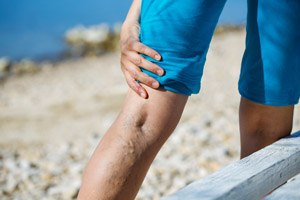-
Are Spider Veins a Precursor to Varicose Veins?
Posted on January 4, 2016 by Vein Admin in spider veins, varicose veins As we age due to heredity, sun exposure, pregnancy, hormonal changes, taking birth control pills, excessive standing or sitting for long periods of time, obesity, tight clothing, and even constipation, sometimes our veins weaken. When veins do not open normally and allow blood flow, the blood can back up, causing swelling. In smaller veins this can cause spider veins.
As we age due to heredity, sun exposure, pregnancy, hormonal changes, taking birth control pills, excessive standing or sitting for long periods of time, obesity, tight clothing, and even constipation, sometimes our veins weaken. When veins do not open normally and allow blood flow, the blood can back up, causing swelling. In smaller veins this can cause spider veins.Spider veins are seen visually though a thin layer of skin. They are often tiny and connect with one another leaving the veins to look somewhat spider webbed in shape. They can be purplish, bluish or reddish in color. Along with being visible to the eye you may also experience: your legs feeling odd or uncomfortable, swelling, itching, restless legs, and even skin ulcers.
Varicose veins are far more pronounced. They are also the result of weak or damaged veins. Blood pools, veins expand and sometimes even twist. They are often times painful and uncomfortable. The causes for both spider and varicose veins are the same. Due to varying physiology, outer influences as well as genetics can present differently in different people.
If you have spider veins, does it mean that over time they will develop into varicose veins?
If you have spider veins, it means you have some level of venous insufficiency taking place in your circulatory system. While it does not directly mean that deeper (larger) veins will be effected, it does lend itself to more of a likelihood than say someone who has no signs at all.
If you are seeing small spider veins popping up on your legs or experiencing strange sensations in your legs, ankles or feet that you cannot put your finger on, it is best to get an evaluation with a vein specialist.
Here at E-vein Screening we offer a FREE online vein evaluation. Simply go to www.eveinscreening.com and click on “Free Virtual Vein Consult. > Get Started” at the middle of the page. Or give Dr. Joseph Magnant’s office a call at 239-694-VEIN.





